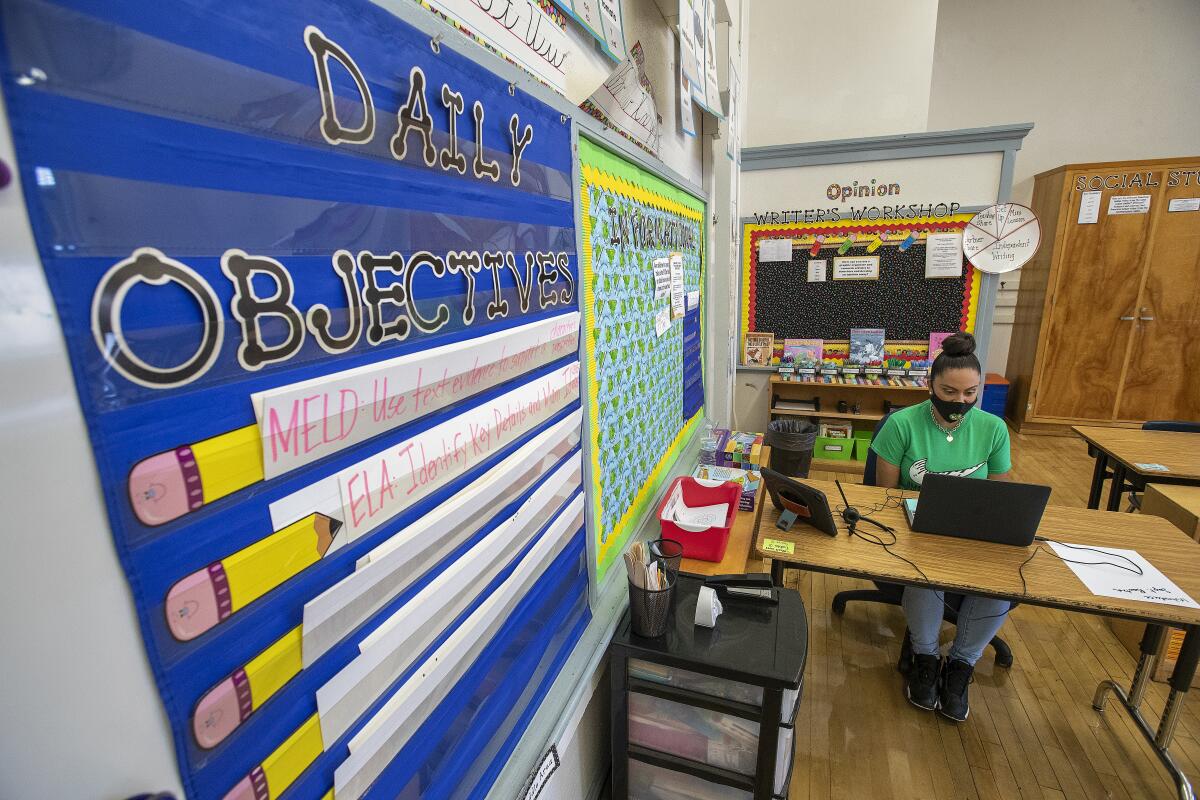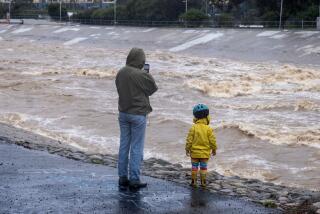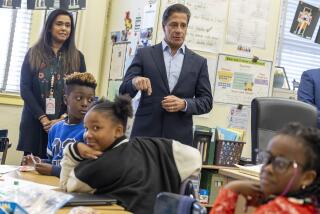‘It’s a frustrating period.’ Yet LAUSD teachers muster smiles on the first day of school

It wasn’t problem free and frustrations flared through the day, but as formal instruction began Thursday in Los Angeles public schools, students, parents and teachers attempted to project a positive face on the difficult work of distance-learning amid the COVID-19 pandemic.
Also on Thursday, L.A. schools Supt. Austin Beutner provided new details on how the district’s nascent COVID-19 testing and contract tracing would work. These plans became slightly more pressing when a county health official suggested that positive health trends could soon permit the potential reopening of elementary schools.
In thousands of classrooms, hundreds of thousands of tiny faces appeared on screen for online classes, provoking worry among some teachers about how they will get to know and inspire their students in a virtual setting.
The district did not release figures Thursday on attendance or enrollment, although several classes observed by The Times were missing only a few children. Thursday‘s snags tended to be technical, whether it was user error, programmer error, beginners bad luck or system overload.
“It’s all of the above and the district is working around the clock to fix it,” said school board member Nick Melvoin, who added that he also saw positives. “Most parents are understanding of the difficulties, but it’s still frustrating, whether an individual iPad is not working or families are just frustrated. It’s a frustrating period.”
Outside groups reported widespread problems.
“There have been lots of technical issues,” said Jenny Hontz, communications director for Speak Up, an advocacy group in contact with several thousand parents. Parents are “spending hours on hold waiting for someone to pick up when they call the district helpline. Many are giving up.”
Another advocacy group reported various problems at a school in South Los Angeles, reflecting the struggles of many families in a district where 80% of students qualify for free or subsidized meals because of low household income. One father, who can’t read or write, could not help his first- and third-grader with their computer woes, for instance.
The students “need to be taught how to log onto the computer independently, but also taught how to log onto their respective platforms since they will have to do this on their own every day,” said Elmer G. Roldan, executive director of Communities in Schools of Los Angeles.
Beutner said the goal is to answer hotline calls within five minutes, which he hoped has been happening the majority of the time.
“We’re doing the best we can,” Beutner said. “We have almost 500,000 students. So there are some peaks.” Besides the technology helpline, families can call the school or consult a family handbook online and or turn to a YouTube help channel. “We’ll get through all the calls and make sure everyone gets the support. This week is meant to be that week to find those issues.”
Melvoin said schools may need more support, because some parents call the school before trying the district hotline, which was picking up calls quickly on Thursday afternoon.
“Teachers are doing IT and their teaching content,” he added, “which is too much.”
The district on Thursday provided access to three schools where teachers were conducting their first lessons on Zoom.
At Eagle Rock Junior-Senior High School, teacher Arlene Alpuerto had the advantage of already knowing many students taking her sports medicine-related classes. But she also anticipates a class roster of about 250 students over six periods — a lot of tiny faces to keep track of on a laptop. Her teaching station has two rooms — a classroom and an exercise room for students learning how to be athletic trainers or athletes learning to condition and avoid injuries.
Elsewhere on campus, Alice Lee was trying to get to know more than 20 seventh-graders who are new to the school in her morning medieval world history class. She understands the importance of making a personal connection with them ; she had strong ties with last year’s students by the time campuses closed in March.
Today, however, the students were strangers on a small screen. About a fourth did not have their cameras turned on. She walked around with her laptop, giving students a tour of a room she’d decorated as though they were going to be there. A bulletin board behind her shouted out: Welcome.
There is so much to figure out.
At Euclid Elementary in Boyle Heights, 11 members of the district’s audiometry department gathered six feet apart in the school’s cafeteria while troubleshooting how to conduct hearing tests. The district conducts approximately 240,000 screenings annually. Typically, a specialist would place a headset over a child and run through close-up tasks.
The mood was upbeat but the Wi-Fi was shaky, forcing them to share ethernet cables. The classrooms, however, seemed to have a strong signal as teachers began their instruction.
Even so, parent Galvina Valverde, who had stopped by to pick up school supplies, could not hide her frustration. She and her husband run a nearby taco stand and worry about their first-grader, Isabella.
“There are times when she will be left alone to learn and I don’t expect a 6-year-old to pay attention,” Valverde said. “This way of learning doesn’t work for everybody.”
Across town at at Kenter Canyon Elementary in Brentwood, attendance was almost perfect in the fourth-grade class of Stephanie Ross. After about 15 minutes of screen time, Ross instructed students to take a “wiggle break.”
Also on Thursday, Beutner provided more detail about the district’s coronavirus testing and tracing program announced on Sunday. Actual testing did not roll out this week, but the plan call for testing school nurses first. These nurses would need a clean bill of health because they would be responsible for testing others.
The next step would be expanding to test staff — especially those working at schools — before moving on to students. He envisioned something like drive-through testing, one line for families with symptoms, another for those without.
A Microsoft app that is supposed to be integral to the effort is going through late-stage testing, he said.
Teacher Jancy Amaya had high praise for the efforts undertaken to open as smoothly as possible.
“The district immediately released tutorials based on the log-in glitches that we had yesterday,” said Amaya, an English learner instructional coach at Cleveland Charter High School in Reseda.
“It does take a village, and I am proud of the resources the district has provided, the combined effort of the dedicated educators at Cleveland, and my administration that has kept us up-to-date with resources throughout the day,” Amaya said.
More to Read
Sign up for Essential California
The most important California stories and recommendations in your inbox every morning.
You may occasionally receive promotional content from the Los Angeles Times.












